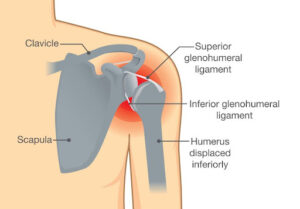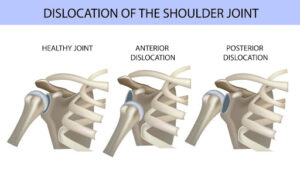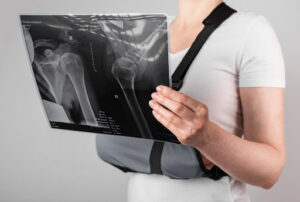Picture this.
It’s a sunny afternoon, and your child is totally absorbed by their favourite outdoor activities—swinging, throwing a ball, or climbing trees. Suddenly, they let out a cry of pain, clutching their shoulder. Panic sets in as you witness their discomfort, and you wonder, “What just happened? How can I help them?”
The shoulder joint is often taken for granted, but it plays a crucial role in our daily lives. It enables us to reach, grasp, and move our arms freely, allowing us to embrace our loved ones, play sports, and accomplish everyday tasks with ease. Unfortunately, a dislocated shoulder can disrupt this harmony, causing pain and hindering our children’s active lifestyles.
In this article, we’ll delve into the world of shoulder injuries, with a particular focus on dislocations and the vital role of first aid in their management. By understanding these injuries, learning the appropriate steps to take and becoming familiar with a shoulder specialist, every parent can be better equipped to handle such situations and ensure their child’s well-being. So, let’s unravel the mysteries of shoulder dislocations and empower ourselves with knowledge for a safer and healthier future.
Understanding the Anatomy of The Shoulder
The shoulder is a remarkable structure composed of bones, muscles, and tendons, working together to provide mobility and stability. At its core, we have the humerus, the upper arm bone, which fits snugly into the shallow socket of the scapula, commonly known as the shoulder blade. This ball-and-socket joint allows for a wide range of motion, just like an expertly engineered mechanical joint.

There is also an essential group of structures within the shoulder that are categorised as the rotator cuff. Think of the rotator cuff as a team of four muscles and their tendons that surround the shoulder joint, creating a protective sheath. These muscles—the supraspinatus, infraspinatus, teres minor, and subscapularis—work harmoniously to stabilise the joint and facilitate fluid movements, like raising the arm or rotating it outward. Their collective strength is crucial in preventing injuries, such as dislocations, and maintaining shoulder stability.
The Shoulder of A Child
As children grow, so do their shoulders. Just as their bodies mature and develop, specific areas of the shoulder undergo significant changes, strengthening and adapting to the demands placed upon them. This evolution can be likened to a blossoming flower, gradually unfurling its petals.
During childhood, the growth plates, also known as epiphyseal plates, within the bones are still active, promoting bone elongation and facilitating skeletal development. These growth plates exist in various parts of the shoulder, including the humerus and the scapula. As the child engages in physical activities and sports, these growth plates are subjected to stress, stimulating bone growth and enhancing the shoulder’s overall strength.
Simultaneously, the muscles and tendons surrounding the shoulder joint undergo continuous strengthening. With regular use and exercise, these soft tissues adapt, becoming more resilient and capable of withstanding the stresses and strains encountered during play and daily activities. So, just like a young tree strengthening its branches, a child’s shoulder gradually evolves, becoming more capable of supporting their active lifestyle.
The Causes and Consequences of Shoulder Dislocations
What Is A Shoulder Dislocation?
Imagine this: Your child takes a fall or makes a sudden, forceful movement, and their shoulder “pops out” of its socket. This is known as a shoulder dislocation. It occurs when the ball-shaped head of the humerus slips out of the shallow socket in the scapula. In some cases, you might witness a moment of relief as the shoulder miraculously “pops back in” by itself, but don’t be fooled by the temporary relief. Whether the shoulder realigns spontaneously or requires assistance, a dislocation is a significant injury that warrants attention and care.
What Can Cause A Shoulder Dislocation?
Shoulder dislocations in children can stem from a variety of causes and scenarios. Falls onto an outstretched arm, sudden impacts during sports activities, or even simple accidents during play can lead to a dislocated shoulder. Children with inherent joint laxity or those involved in contact sports like football or gymnastics are particularly prone to this injury. Vigorous pulling or tugging of the arm, common during rough play or sports, can also contribute to shoulder dislocations. It is crucial to remain vigilant and take precautionary measures to minimise the risk of such accidents.

What Damage Can Occur?
The consequences of a dislocated shoulder extend beyond the initial discomfort. The structures within the shoulder, including the rotator cuff, can suffer damage during the dislocation. The rotator cuff, comprising muscles and tendons, plays a vital role in stabilising the joint. A dislocation can strain or tear these tissues, compromising their function and stability. Additionally, repeated dislocations or inadequate management can lead to chronic instability, increased vulnerability to future dislocations, and potential long-term complications. Understanding the potential damage caused by a dislocated shoulder highlights the importance of timely intervention and appropriate management to safeguard the overall health and functionality of the shoulder joint.
First Aid and Management of Shoulder Dislocations
In the period immediately after your child sustains a shoulder location, it can be a frenetic and distressing time, but preparation and prior knowledge can be important in ensuring your child does not sustain any further injury. By developing an understanding of quality first aid practices for the period immediately after the injury, and learning about the management of shoulder dislocations in the long term, you’ll be able to help your child throughout the process.
What To Do Straight After The Incident
When a shoulder dislocation occurs, it’s crucial to provide immediate first aid. Start by keeping your child calm and supporting their arm to prevent further movement. First aid for a dislocated shoulder should begin with gently apply a cold compress or ice pack wrapped in a cloth to reduce pain and swelling. Avoid any attempts to forcefully relocate the shoulder yourself, as this can cause further damage. Instead, seek medical assistance promptly.
What If The Dislocated Shoulder Pops Back In By Itself?
In some fortunate cases, a dislocated shoulder may spontaneously “pop back in” by itself. While this may temporarily alleviate the discomfort, it is still essential to consult a shoulder specialist. They can assess the shoulder’s stability, identify any underlying damage, and provide appropriate guidance for further management. Even if the shoulder self-realigns, it is crucial to address the root cause and prevent future dislocations.
Long-Term Management of Shoulder Dislocations
Effective management of shoulder dislocations involves both immediate first aid and long-term care. Immediate dislocation first aid includes seeking medical attention, receiving a proper diagnosis, and potentially undergoing imaging tests, such as X-rays or MRI scans.

Treatment options may vary depending on the severity and nature of the dislocation, ranging from gently closed reduction procedures to surgical intervention. Following the initial phase, long-term dislocation management typically involves a comprehensive rehabilitation program that focuses on strengthening the shoulder, improving stability, and restoring range of motion. Physical therapy exercises, targeted stretching, and gradual return to activities are often integral components of this management plan.
Take Positive Steps To Optimise Your Child’s Shoulder Health Today!
Shoulder dislocations can be painful and disruptive, but with the right treatment and management strategies, individuals can find relief and regain optimal shoulder function. Exploring various shoulder dislocation management options is essential, ranging from immediate first aid steps like keeping the child calm and applying a cold compress to seeking medical attention for proper diagnosis and potential imaging tests. Treatment options for shoulder dislocations may include gently closed reduction procedures or, in severe cases, surgical intervention.
Don’t hesitate to get in touch with Dr Stuart Kirkham at the Sydney Orthopaedic Surgeon Clinic if you are struggling with a shoulder dislocation and need assistance. With his expertise, he can guide you towards achieving relief and enhancing your overall well-being.


